Node Drawtypes
Introduction
The method by which a node is drawn is called a drawtype. There are many available drawtypes. The behaviour of a drawtype can be controlled by providing properties in the node type definition. These properties are fixed for all instances of this node. It is possible to control some properties per-node using something called param2.
In the previous chapter, the concept of nodes and items was introduced, but a full definition of a node wasn’t given. The Minetest world is a 3D grid of positions. Each position is called a node, and consists of the node type (name) and two parameters (param1 and param2). The function core.register_node is a bit misleading in that it doesn’t actually register a node - it registers a new type of node.
The node params are used to control how a node is individually rendered. param1 is used to store the lighting of a node, and the meaning of param2 depends on the paramtype2 property of the node type definition.
- Cubic Nodes: Normal and Allfaces
- Glasslike Nodes
- Airlike Nodes
- Lighting and Sunlight Propagation
- Liquid Nodes
- Node Boxes
- Mesh Nodes
- Signlike Nodes
- Plantlike Nodes
- Firelike Nodes
- More Drawtypes
Cubic Nodes: Normal and Allfaces
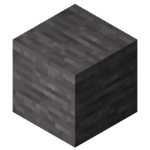
The normal drawtype is typically used to render a cubic node. If the side of a normal node is against a solid side, then that side won’t be rendered, resulting in a large performance gain.
In contrast, the allfaces drawtype will still render the inner side when up against a solid node. This is good for nodes with partially transparent sides, such as leaf nodes. You can use the allfaces_optional drawtype to allow users to opt-out of the slower drawing, in which case it’ll act like a normal node.
core.register_node("mymod:diamond", {
description = "Alien Diamond",
tiles = {"mymod_diamond.png"},
groups = {cracky = 3},
})
core.register_node("default:leaves", {
description = "Leaves",
drawtype = "allfaces_optional",
tiles = {"default_leaves.png"}
})
Note: the normal drawtype is the default drawtype, so you don’t need to explicitly specify it.
Glasslike Nodes
The difference between glasslike and normal nodes is that placing a glasslike node next to a normal node won’t cause the side of the normal node to be hidden. This is useful because glasslike nodes tend to be transparent, and so using a normal drawtype would result in the ability to see through the world.
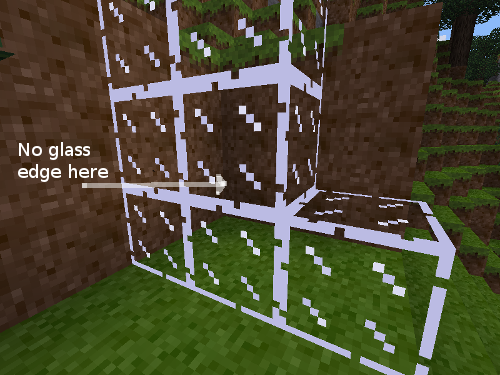
core.register_node("default:obsidian_glass", {
description = "Obsidian Glass",
drawtype = "glasslike",
tiles = {"default_obsidian_glass.png"},
paramtype = "light",
is_ground_content = false,
sunlight_propagates = true,
sounds = default.node_sound_glass_defaults(),
groups = {cracky=3,oddly_breakable_by_hand=3},
})
Glasslike_Framed
This makes the node’s edge go around the whole thing with a 3D effect, rather than individual nodes, like the following:
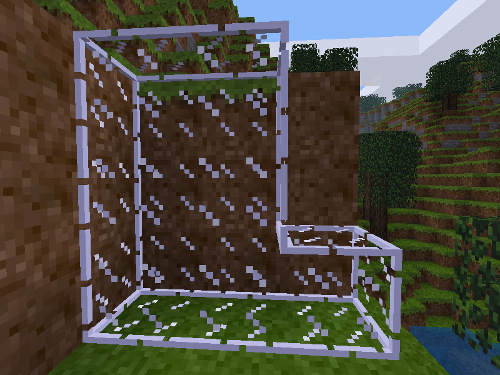
You can use the glasslike_framed_optional drawtype to allow the user to opt-in to the framed appearance.
core.register_node("default:glass", {
description = "Glass",
drawtype = "glasslike_framed",
tiles = {"default_glass.png", "default_glass_detail.png"},
inventory_image = core.inventorycube("default_glass.png"),
paramtype = "light",
sunlight_propagates = true, -- Sunlight can shine through block
groups = {cracky = 3, oddly_breakable_by_hand = 3},
sounds = default.node_sound_glass_defaults()
})
Airlike Nodes
These nodes are not rendered and thus have no textures.
core.register_node("myair:air", {
description = "MyAir (you hacker you!)",
drawtype = "airlike",
paramtype = "light",
sunlight_propagates = true,
walkable = false, -- Would make the player collide with the air node
pointable = false, -- You can't select the node
diggable = false, -- You can't dig the node
buildable_to = true, -- Nodes can replace this node.
-- (you can place a node and remove the air node
-- that used to be there)
air_equivalent = true,
drop = "",
groups = {not_in_creative_inventory=1}
})
Lighting and Sunlight Propagation
The lighting of a node is stored in param1. In order to work out how to shade a node’s side, the light value of the neighbouring node is used. Because of this, solid nodes don’t have light values because they block light.
By default, a node type won’t allow light to be stored in any node instances. It’s usually desirable for some nodes such as glass and air to be able to let light through. To do this, there are two properties which need to be defined:
paramtype = "light",
sunlight_propagates = true,
The first line means that param1 does, in fact, store the light level. The second line means that sunlight should go through this node without decreasing in value.
Liquid Nodes
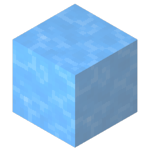
Each type of liquid requires two node definitions - one for the liquid source, and another for flowing liquid.
-- Some properties have been removed as they are beyond
-- the scope of this chapter.
core.register_node("default:water_source", {
drawtype = "liquid",
paramtype = "light",
inventory_image = core.inventorycube("default_water.png"),
-- ^ this is required to stop the inventory image from being animated
tiles = {
{
name = "default_water_source_animated.png",
animation = {
type = "vertical_frames",
aspect_w = 16,
aspect_h = 16,
length = 2.0
}
}
},
special_tiles = {
-- New-style water source material (mostly unused)
{
name = "default_water_source_animated.png",
animation = {type = "vertical_frames", aspect_w = 16,
aspect_h = 16, length = 2.0},
backface_culling = false,
}
},
--
-- Behavior
--
walkable = false, -- The player falls through
pointable = false, -- The player can't highlight it
diggable = false, -- The player can't dig it
buildable_to = true, -- Nodes can be replace this node
alpha = 160,
--
-- Liquid Properties
--
drowning = 1,
liquidtype = "source",
liquid_alternative_flowing = "default:water_flowing",
-- ^ when the liquid is flowing
liquid_alternative_source = "default:water_source",
-- ^ when the liquid is a source
liquid_viscosity = WATER_VISC,
-- ^ how fast
liquid_range = 8,
-- ^ how far
post_effect_color = {a=64, r=100, g=100, b=200},
-- ^ colour of screen when the player is submerged
})
Flowing nodes have a similar definition, but with a different name and animation. See default:water_flowing in the default mod in minetest_game for a full example.
Node Boxes
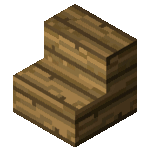
Node boxes allow you to create a node which is not cubic, but is instead made out of as many cuboids as you like.
core.register_node("stairs:stair_stone", {
drawtype = "nodebox",
paramtype = "light",
node_box = {
type = "fixed",
fixed = {
{-0.5, -0.5, -0.5, 0.5, 0, 0.5},
{-0.5, 0, 0, 0.5, 0.5, 0.5},
},
}
})
The most important part is the node box table:
{-0.5, -0.5, -0.5, 0.5, 0, 0.5},
{-0.5, 0, 0, 0.5, 0.5, 0.5}
Each row is a cuboid which are joined to make a single node. The first three numbers are the co-ordinates, from -0.5 to 0.5 inclusive, of the bottom front left most corner, the last three numbers are the opposite corner. They are in the form X, Y, Z, where Y is up.
You can use the NodeBoxEditor to create node boxes by dragging the edges, it is more visual than doing it by hand.
Wallmounted Node Boxes
Sometimes you want different nodeboxes for when it is placed on the floor, wall, or ceiling like with torches.
core.register_node("default:sign_wall", {
drawtype = "nodebox",
node_box = {
type = "wallmounted",
-- Ceiling
wall_top = {
{-0.4375, 0.4375, -0.3125, 0.4375, 0.5, 0.3125}
},
-- Floor
wall_bottom = {
{-0.4375, -0.5, -0.3125, 0.4375, -0.4375, 0.3125}
},
-- Wall
wall_side = {
{-0.5, -0.3125, -0.4375, -0.4375, 0.3125, 0.4375}
}
},
})
Mesh Nodes
Whilst node boxes are generally easier to make, they are limited in that they can only consist of cuboids. Node boxes are also unoptimised; Inner faces will still be rendered even when they’re completely hidden.
A face is a flat surface on a mesh. An inner face occurs when the faces of two different node boxes overlap, causing parts of the node box model to be invisible but still rendered.
You can register a mesh node as so:
core.register_node("mymod:meshy", {
drawtype = "mesh",
-- Holds the texture for each "material"
tiles = {
"mymod_meshy.png"
},
-- Path to the mesh
mesh = "mymod_meshy.b3d",
})
Make sure that the mesh is available in a models directory. Most of the time the mesh should be in your mod’s folder, however, it’s okay to share a mesh provided by another mod you depend on. For example, a mod that adds more types of furniture may want to share the model provided by a basic furniture mod.
Signlike Nodes
Signlike nodes are flat nodes with can be mounted on the sides of other nodes.
Despite the name of this drawtype, signs don’t actually tend to use signlike but instead use the nodebox drawtype to provide a 3D effect. The signlike drawtype is, however, commonly used by ladders.
core.register_node("default:ladder_wood", {
drawtype = "signlike",
tiles = {"default_ladder_wood.png"},
-- Required: store the rotation in param2
paramtype2 = "wallmounted",
selection_box = {
type = "wallmounted",
},
})
Plantlike Nodes
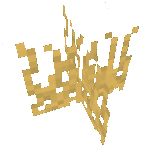
Plantlike nodes draw their tiles in an X like pattern.
core.register_node("default:papyrus", {
drawtype = "plantlike",
-- Only one texture used
tiles = {"default_papyrus.png"},
selection_box = {
type = "fixed",
fixed = {-6 / 16, -0.5, -6 / 16, 6 / 16, 0.5, 6 / 16},
},
})
Firelike Nodes
Firelike is similar to plantlike, except that it is designed to “cling” to walls and ceilings.
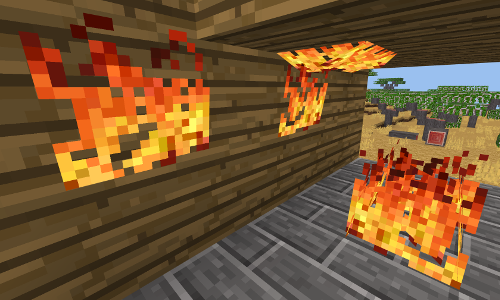
core.register_node("mymod:clingere", {
drawtype = "firelike",
-- Only one texture used
tiles = { "mymod:clinger" },
})
More Drawtypes
This is not a comprehensive list, there are more types including:
- Fencelike
- Plantlike rooted - for underwater plants
- Raillike - for cart tracks
- Torchlike - for 2D wall/floor/ceiling nodes. The torches in Minetest Game actually use two different node definitions of mesh nodes (default:torch and default:torch_wall).
As always, read the Lua API documentation for the complete list.